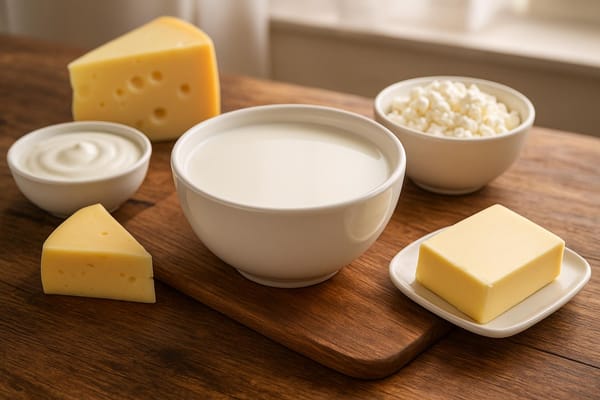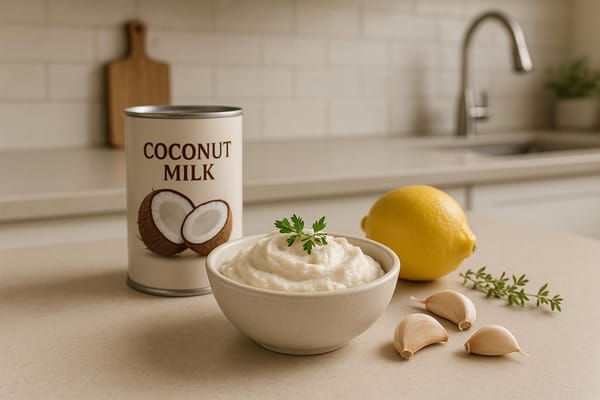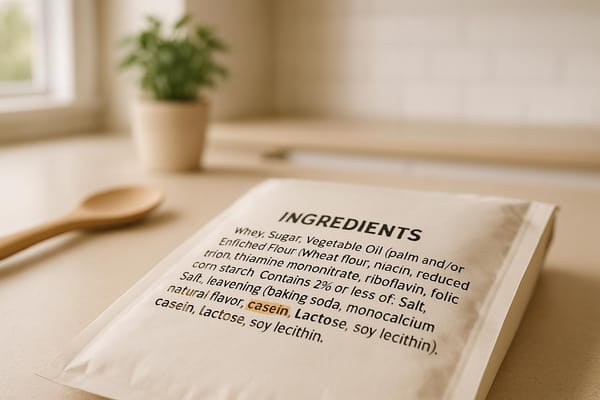Best Plant-Based Milks for Cooking
Explore the best plant-based milks for cooking, their unique flavors, textures, and ideal uses in savory and sweet recipes.

Plant-based milks are now a staple in many kitchens, offering options for those with dietary restrictions or preferences. Each type - soy, almond, oat, and coconut milk - has unique qualities that make it suitable for specific recipes. Here's a quick rundown:
- Soy Milk: High protein, creamy texture, great for baking and savory dishes. Best for high-heat recipes but avoid boiling directly.
- Almond Milk: Light and nutty, low in calories, ideal for light recipes, soups, and smoothies. Thin consistency makes it less effective for creamy dishes.
- Oat Milk: Naturally sweet and creamy, perfect for desserts, coffee, and hearty dishes like soups and stews.
- Coconut Milk: Rich and thick, adds depth to curries, sauces, and tropical desserts. Available in canned (thicker) and carton (lighter) forms.
Quick Comparison:
| Feature | Soy Milk | Almond Milk | Oat Milk | Coconut Milk |
|---|---|---|---|---|
| Flavor | Neutral, slight "bean" | Nutty, mild, sweet | Sweet, toasted oats | Tropical, sweet |
| Texture | Thick, creamy | Light, thin | Creamy, rich | Thick, velvety |
| Protein | High (≈7g/cup) | Low (≈2g/cup) | Moderate (≈3g/cup) | Low (≈0g/cup) |
| Calories | 80–100/cup | 30–60/cup | 120/cup | 50/cup |
| Best Uses | Baking, savory dishes | Light recipes, smoothies | Desserts, coffee, soups | Curries, rich sauces |
| Heat Stability | Excellent | Poor | Good | Excellent |
Choose the right plant-based milk based on your recipe's needs, and experiment to find your favorite. Each option brings something unique to the table.
Plant-based Milks Tested and Compared by ConsumerLab - Learn the Differences

1. Soy Milk
Soy milk stands out as a go-to option among plant-based milks, thanks to its versatility in cooking. Packed with nearly as much protein as dairy milk but with less fat and no cholesterol, it has become a favorite for those aiming to eat healthier or avoid dairy altogether. Let’s dive into its flavor, texture, and how it shines in the kitchen.
Flavor
Soy milk has a mild, creamy taste with a hint of "beany" flavor that varies slightly between brands. This subtle flavor profile allows it to blend seamlessly into a wide range of dishes. Unsweetened soy milk is perfect for savory recipes like soups and sauces, while sweetened varieties can add a touch of richness to desserts and baked goods without overpowering other ingredients.
Texture
One of soy milk’s standout features is its thick and creamy consistency, which is richer than almond milk. This makes it an excellent choice for recipes that need a bit of body, like sauces, soups, or baked goods. Its high protein content not only contributes to its creaminess but also helps it hold up well in cooking.
Best Uses
Thanks to its robust protein structure, soy milk excels in high-heat cooking. It’s ideal for simmering soups, creating rich sauces, and adding depth to both savory and sweet dishes.
"Yes, soy milk is one of the best dairy alternative milks you can choose when it comes to making creamy vegan sauces."
- Kelly, Earth to Veg
Considerations
When using soy milk in cooking, temperature control matters. Adding it directly to boiling liquids can cause separation. To avoid this, gently warm the soy milk beforehand and incorporate it gradually for a smooth, even texture.
"Unsweetened, plain soy milk (no vanilla added - check the ingredients list) is almost always a safe bet in any type of stovetop or baking recipe, due to its neutral flavor and thickness."
- Erin Huffstetler, Writer
For savory recipes, always choose unsweetened soy milk to maintain the intended flavor of the dish. It’s also a good idea to test in small batches, allowing you to fine-tune seasonings as needed.
2. Almond Milk
Almond milk brings a subtle, nutty sweetness to the kitchen, making it a favorite plant-based milk for cooking. Its light texture and mild flavor make it versatile in a variety of recipes. Let’s break down its key qualities for cooking.
Flavor
Almond milk adds a gentle, nutty sweetness to dishes without overwhelming other ingredients. The exact flavor can vary depending on the brand and type - some are more watery, others creamier; some emphasize nuttiness, while others lean sweeter. Sweetened almond milk includes added sugar, giving it a richer sweetness, while unsweetened almond milk is sugar-free and lower in calories. For savory dishes, unsweetened almond milk is the better option since it avoids introducing unwanted sweetness.
It’s best to skip flavored almond milk in savory recipes, as the added sweeteners or flavors can disrupt the intended taste.
Texture
With its thin, watery consistency, almond milk is lighter than many other plant-based milks. This makes it excellent for creating smooth and silky pasta sauces without adding heaviness. In baking, it contributes to light and airy textures in cakes and muffins, helping achieve a delicate crumb. Its thinner texture also works well in smoothies and other blended drinks.
Best Uses
Almond milk is a versatile option for both sweet and savory dishes and can replace cow's milk in recipes on a 1:1 basis. It’s a great choice for baking cakes, cookies, and blending into smoothies. On the savory side, it’s ideal for making creamy soups, curries, casseroles, and smooth rouxs.
Considerations
If you’re using sweetened almond milk for baking, you may need to adjust the sugar in your recipe to avoid it becoming too sweet. Its thin consistency, however, makes it less effective as a coffee creamer. For the best results in baking, opt for a neutral almond milk with minimal additives.
3. Oat Milk
Oat milk stands out for its creamy texture and gentle sweetness, making it a versatile choice for both sweet and savory recipes. Its rich, balanced profile has made it a favorite in kitchens and coffee shops alike.
Flavor
Oat milk has a natural sweetness that comes from the breakdown of starches during processing. This sweetness is subtle, with nutty and creamy undertones that blend harmoniously with other ingredients. Unlike soy or almond milk, oat milk contains just 1 gram of sugar per serving, offering a mild sweetness that enhances a variety of dishes without overpowering them.
One of its standout qualities is how it avoids the sourness that steamed cow's milk can sometimes develop. As food writer Elazar Sontag puts it:
"Oat milk is slightly sweet, without the almost sour taste that steamed cow's milk sometimes takes on. It has just enough oaty flavor to be recognizable but not so much as to be off-putting or clash with coffee's natural acidity."
For savory recipes, a pinch of salt can help balance oat milk's natural sweetness. Its mild flavor also makes it an excellent option for baking. Pastry expert Stella (Pastry Wizard) shares her thoughts:
"I love oat milk, and it's great for baking... oat milk's mildness is particularly useful compared to stronger-flavored alternatives like almond or coconut milk."
This combination of balanced flavor and creamy texture makes oat milk a standout ingredient in countless recipes.
Texture
Oat milk's creamy, dense texture closely resembles dairy milk, bringing richness without feeling heavy. This makes it a favorite for frothing, especially in coffee drinks like lattes, where it creates a velvety finish.
Best Uses
Thanks to its flavor and texture, oat milk shines in a wide range of culinary applications. In baking, its natural sweetness and carbohydrate content enhance the flavor, texture, and even the color of baked goods. Its creamy consistency ensures moist and tender results in treats like vegan chocolate chip cookies, dairy-free vanilla cupcakes, chocolate buttercream frosting, and chocolate pudding. Blueberry corn muffins made with oat milk, for example, have been found to taste nearly identical to those made with dairy milk.
On the savory side, oat milk works beautifully in dishes like mac and cheese, mashed potatoes, creamy soups, and pasta. It’s also an excellent base for dairy-free béchamel sauce and marinades. Compared to alternatives like coconut or soy milk, oat milk’s neutral flavor makes it a more versatile option for savory cooking.
Considerations
To get the best results when cooking with oat milk, keep a few key tips in mind. If your recipe already contains significant sugar, consider reducing the added sugar to keep the sweetness balanced. For more control over the final flavor, opt for unsweetened oat milk, which works well in both sweet and savory dishes. Store-bought oat milk is generally more reliable for baking than homemade versions, as it provides consistent results.
Oat milk’s flavor pairs particularly well with golden-brown, wheat-based baked goods, adding a toasty, comforting quality. It can even enhance the oat flavor in oatmeal, making for a cozy breakfast option.
4. Coconut Milk
Coconut milk brings a creamy, tropical touch to a wide range of dishes, making it a go-to ingredient for both home cooks and chefs.
Flavor
Coconut milk has a natural sweetness that works well in both savory and sweet recipes. Carton coconut milk tends to have a lighter flavor, making it a versatile choice for everyday cooking, while canned coconut milk offers a more intense taste. Its ability to enhance other flavors without dominating them is one of its standout features. As Cheetie Kumar, chef and owner of Garland, puts it:
"Coconut milk can tolerate a lot of different spices and complexities of flavor, takes acid so well, and brings up the fruity nuances of everything it's involved with... I can't really think of an application where I wouldn't use it."
This adaptability allows coconut milk to balance bold spices and aromatic ingredients seamlessly. If the coconut flavor feels too strong, ingredients like lime, tamarind, or fish sauce can help tone it down.
Texture
Canned coconut milk is known for its rich, creamy consistency, thanks to its higher fat content. This fat not only gives it a luscious texture but also helps carry flavors in a dish. Thai chef and cookbook author Pailin Chongchitnant highlights this point:
"You might as well add water, because its fat carries the flavor. So when you remove the fat, you remove the flavor."
The thick, velvety texture of canned coconut milk is ideal for creamy soups, stews, and desserts. It adds a satisfying richness to sauces and ensures a luxurious mouthfeel in every bite.
Best Uses
Coconut milk is a cornerstone ingredient in Southeast Asian, Caribbean, and Indian cuisines. As Pacific Foods notes:
"Coconut milk is a mainstay in most cooking traditions in Southeast Asia, the Caribbean and India. It enhances savory curries, stews and soups, giving them a smooth, velvety texture. It complements sweet treats as well and is a great base for desserts like Thai coconut custard or Brazilian coconut brigadeiros."
In savory dishes, coconut milk shines in curries, where it pairs beautifully with spices like turmeric, ginger, and cumin, adding creaminess and depth. It’s also a fantastic choice for soups like coconut lentil, Thai coconut, or butternut squash soup, and it enhances the richness of hearty stews. On the sweeter side, coconut milk is perfect for desserts, frostings, fillings, and even beverages like smoothies and specialty coffee drinks.
Considerations
When using coconut milk, it’s best to add it gradually and taste as you go. The flavor and consistency can vary between brands and types, so this approach helps you achieve the right balance. Canned coconut milk is ideal for recipes that need a thicker texture and a stronger coconut flavor, while carton coconut milk works better as a dairy substitute in lighter dishes. To avoid curdling, keep the heat low to medium when simmering and add acidic ingredients like tomatoes or citrus toward the end of cooking.
Comparison: Pros and Cons
Taking a closer look at the plant-based milk options discussed earlier, here’s a breakdown of their standout qualities and potential drawbacks. Each type shines in certain cooking scenarios, but understanding their differences can help you pick the best one for your diet and recipes.
Soy milk is often the go-to choice for versatility. With around 7 grams of protein per cup, it’s a strong contender for both sweet and savory dishes. Its neutral flavor and ability to handle heat make it a favorite for baking and hot recipes. That said, some people aren’t fans of its taste, describing it as "bean-like", and it’s a frequent allergen.
Oat milk is loved for its creamy texture and natural sweetness, which enhances recipes without overpowering them. As Pacific Foods notes:
"Oat milk has a more neutral flavor than other plant-based alternatives. It is also less likely to change the taste of what you're making - its lightly toasted oat flavor actually enhances the flavor profile of many treats."
This makes oat milk a standout for coffee drinks and desserts. However, with 16 grams of carbohydrates and 120 calories per serving, it’s not ideal for low-carb cooking.
For those watching their calorie intake, almond milk is a solid choice. At just 30–60 calories per cup, it’s one of the lightest options. Its mild, nutty flavor fits well in many recipes, though it struggles with heat and may separate when warmed.
Coconut milk, especially in its canned form, brings richness to recipes. Its high fat content makes it perfect for cream sauces and curries, though it’s not the best pick if you’re trying to limit saturated fat. Its tropical flavor pairs beautifully with Southeast Asian dishes but can overpower more subtle recipes.
| Feature | Soy Milk | Almond Milk | Oat Milk | Coconut Milk |
|---|---|---|---|---|
| Flavor | Neutral; slight "bean" note | Nutty, mild, slightly sweet | Sweet with toasted oat notes | Tropical, sweet |
| Texture | Similar to cow's milk | Light, thin | Creamy, like cow's milk | Rich, smooth, thick |
| Protein | High (≈7 g per cup) | Low (≈2 g per cup) | Moderate (≈3 g per cup) | Low (0 g per cup) |
| Calories | 80–100 per cup | 30–60 per cup | 120 per cup | 50 per cup |
| Best For | Baking, savory dishes | Light recipes, low-calorie needs | Coffee drinks, desserts | Curries, cream sauces |
| Heat Stability | Excellent | Poor (tends to separate) | Good | Excellent |
| Allergen Concerns | Soy allergy | Tree nut allergy | Possible gluten cross-contamination | Generally safe |
Experts often recommend soy milk for baking because of its protein and fat content. Coconut milk, on the other hand, is ideal for cream-based dishes, while oat milk’s natural sweetness and stability make it a favorite for soups and stews.
Allergens are another important factor to consider. Oat milk is generally allergy-friendly, though there’s a risk of gluten cross-contamination for some. Almond milk isn’t suitable for those with tree nut allergies, and soy milk is off the table for individuals with soy sensitivities.
On a broader scale, plant-based milks now account for about 16% of all milk consumed in the U.S., with the global market projected to hit $38 billion by 2024 and triple by 2030. This growth reflects increasing awareness of health advantages and environmental concerns - especially since cow’s milk has a carbon footprint that’s 2.5 to 3 times larger than its plant-based counterparts.
Conclusion
Choosing the right plant-based milk can make all the difference in your recipes. For instance, soy milk's neutral color and balanced protein and fat content make it a great choice for both baking and savory dishes, as Mary Margaret Chappell highlights. Oat milk brings a natural sweetness and creamy texture, almond milk works well in lighter recipes or for those watching their calorie intake, and coconut milk adds richness to curries and cream-based sauces. The trick is to experiment and find the option that best complements your dish.
For those who prefer to stick with dairy but face lactose intolerance, there’s a solution. Milktab offers a compact digestive aid designed to help you enjoy dairy without discomfort. Its triple-enzyme formula includes 27,000 FCC units of lactase, 22,000 FCC units of protease, and 1,000 FCC units of lipase, aiding in the digestion of lactose, proteins, and fats. This makes it easier to include regular dairy milk in your favorite recipes. As one Amazon customer, DPJ1168, shared:
"I can now enjoy regular milk, cheese, and ice cream without the dreaded side effects."
FAQs
How can I stop plant-based milks like almond or soy from separating when cooking?
To prevent plant-based milks like almond or soy from separating during cooking, heat them slowly over low to medium heat while stirring often. Boiling should be avoided, as it can lead to separation. Gently warming the milk before combining it with hot ingredients can also help keep its texture smooth. For added stability, consider mixing in a small amount of fat, like a teaspoon of coconut oil or a few drops of neutral cooking oil, to reduce the risk of curdling.
What’s the best plant-based milk for making creamy sauces and soups without adding too many calories?
For creamy sauces and soups that won't pack on the calories, unsweetened almond milk is a great option. Its light texture and subtle flavor make it easy to mix into recipes without taking over the taste.
If you're after something with a bit more creaminess, unsweetened oat milk is worth considering. Though it has slightly more calories than almond milk, its richer texture is perfect for dishes like chowders or bisques.
What allergens should I watch out for when cooking with plant-based milks?
When using plant-based milks in your cooking, it’s crucial to keep potential allergens in mind. Nut-based milks like almond, cashew, and hazelnut can pose risks for those with nut allergies. Similarly, soy milk is a frequent allergen to watch out for. While coconut milk isn’t technically a nut, it can still cause allergic reactions in some people. Additionally, oat milk might be problematic if the oats aren’t certified gluten-free, as cross-contamination with gluten can happen during processing.
To stay safe, always read ingredient labels and look for certifications, especially when preparing food for someone with allergies or sensitivities.



